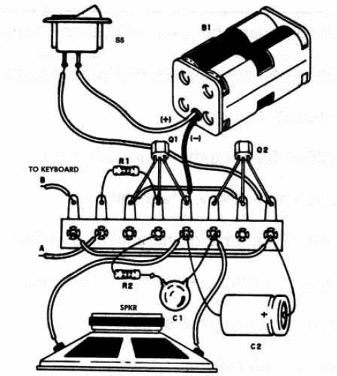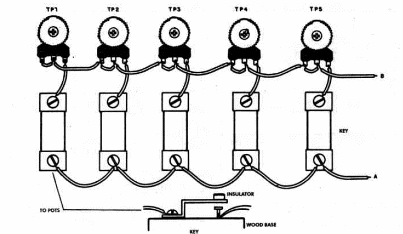This is an interesting experiment in audio which would make a nice toy for children.
This circuit produces a musical note by pressing a key on a keyboard. The sound is produced by a small speaker.
The electronic organ will play only one note at a time, but the number of notes is unlimited.
Different tones can be selected by pressing different keys, as in a common electronic organ.
Tonal range is determined by C1, which can be altered within a large range of values.
Values between 0.022 µF (for higher notes) and 1 µF (for lower notes) can be experimented.
You can also use this circuit as a multi-tone bell in your home or to monitor several places at the same time.
Replacing the keys with different sensors (reed switches, for instance) will produce different tones when closed.
A schematic diagram of the simple Electronic Organ is given in Figure 1.

The circuit consistis of a simple two-transistor oscillator.
The transistors are direct- coupled and drive a small loudspeaker.
Components layout, using a terminal strip as chassis is, shown in Figure 2.

The circuit can be housed in the same box as the keyboard.
In Figure 3 we show the layout of the keyboard. Each trimmer potentiometer is used to adjust individual notes.

The circuit can be powered from AA cells or a power supply ranging from 3 to 6 volts.
The keyboard can also be made from a printed-circuit board or with small metal plates.
When each metal plate is touched by a probe the corresponding circuit closes and a musical tone is produced.
Electronic Organ
Q1 - BC548 general-purpose NPN silicon transistor
Q2 - BC558 general-purpose PNP silicon transistor
S1-4 – keyboard - see text
P1-4 - 1,000,000 ohm trimmer potentiometer
R1 - 10,000 ohm, ¼ W, 5% resistor
Ct - 0.047 µF ceramic or metal film capacitor
C2 - 100 µF, 12 WVDC electrolytic capacitor
SS - SPST toggle or slide switch
B1 - 3 or 6V - AA cells
SPKRl - 4/8 ohm, 2 to 4 in. - small loudspeaker
Ideas to Explore
To learn more about the circuit or to get better performance:
Alter C1 in the range given in the text to produce a different range of sounds.
Explain how the circuit works.
Try to replace R1 with a network formed by small transformers, diodes, resistors, capacitors and other components. Modifications in the tone pitch could be found this way.
Science and uncommon applications:
Replace S1, S2, etc., with different kinds of switches. You can identify the closed switch by the tone.
Use only one potentiometer coupled to a cursor. You can produce music by rapidly changing cursor position and pressing the series switch.
The same keyboard can be used in other audio oscillators, resulting in different configurations of electronic organ.



